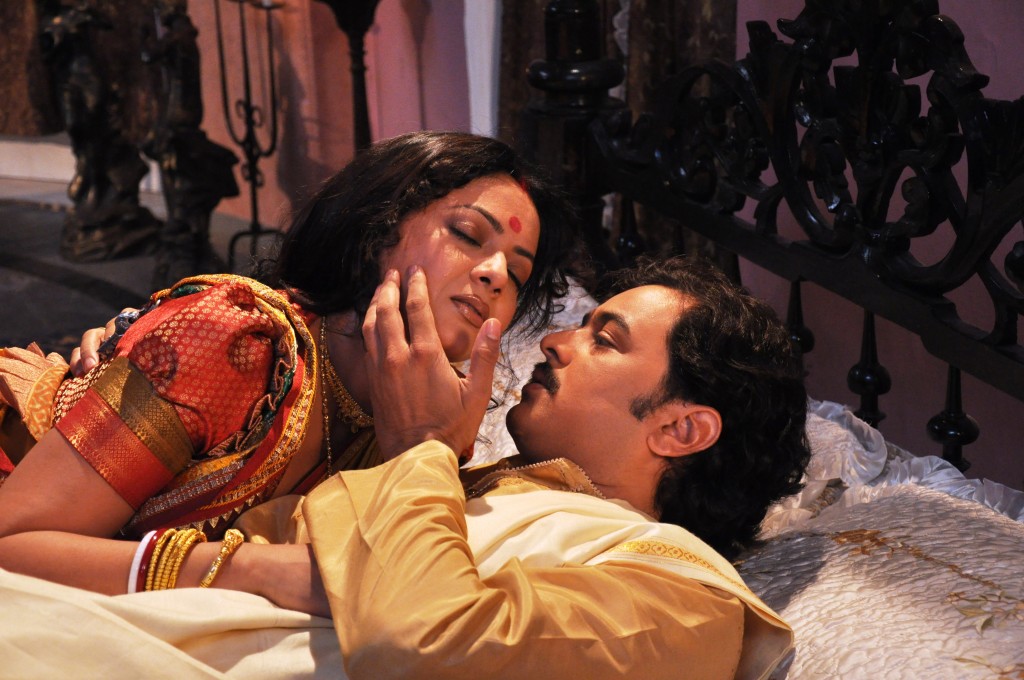The debutant director Reema Mukherjee claims that Ardhangini – Ek Ardhasatya is inspired from Tagore’s novel Ghare Baire, adapted by Satyajit Ray in 1984. This novel was originally published in Bengali in 1915, two years after the author was awarded the Nobel Prize for Literature and the same year in which he received a knighthood from King George V of England – an accolade he renounced in 1919 in protest against the Jallianwallah Bagh massacre in Punjab.
The story coincides with the National Independence Movement in the country at the time sparked by the Indian National Congress. There were various national and regional campaigns of both militant and non-violent ideas which all had the common goal of ending British colonial rule. Militant nationalism had a strong showing in the early part of the 20th century, especially during World War I.
The controversial nature of the subject matter, in which Tagore takes the opportunity to launch his fiercest attack yet against the ideology of nationalism, contrary to its rising popularity both in India and the West, was one reason for its drawing attention, mostly in the form of re-probation and scorn, from readers both in and outside Bengal.
Mukherjee’s screenplay and direction tries to adhere to the political context of nationalism looked at from two diametrically opposed points by Nikhilesh Choudhury (Subodh Bhave) who is the raja (zamindar) of Sukhsayor and Sandip (Subrat Dutt), his childhood friend who arrives as a house guest at Nikhilesh’s palatial mansion and uses this as a base to spread his message of nationalism in the village. Nikhilesh, an open-minded, generous zamindar whose village is united because of his deep conviction in a welfare state, and who believes in the freedom of the individual, introduces Sandip to his beautiful wife Bimala (Sreelekha Mitra). Bimala, who has never set eyes on another man, feels a deep pull towards the charismatic Sandip who initiates her into his movement to motivate the villagers to burn all British-made goods and stick to Swadeshi products which Nikhilesh vehemently opposes because he believes that the poor cannot afford home-made goods as they are much more expensive than the British goods.
The village landscape has been brought out quite well including the interiors of the zamindar’s mansion where Nikhilesh’s two widowed sisters-in-law (Varsha Usgaonkar and Reema Lagu) bask in the comfort and care of their caring brother-in-law. It is Bimala who topples the balance and disturbs the harmony of this family by entering into an adulterous liaison with Sandip who she finds so different and so attractive when compared with her low-key, soft-spoken and sophisticated husband. Sandip uses this attraction to make her the head of the local movement which works well with the Hindus but scares off the Muslims creating the first ever rift in the Hindu-Muslim confluence in Sukhsayor.
Mukherjee also dubs the film a musical. It has some wonderful songs drawn from different schools of music voiced by some of the best-known voices in music in the country. Dinesh Arjun’s musical score is very good but could have been less loud and subtle. Manoj Mitra as the village headmaster who also taught Nikhilesh and Sandip at school is wasted in a character that needed more fleshing out. Sreelekha as Bimala does her job well and looks beautiful both when decked up in jewellery as well as when she gives up much of the ornamentation after joining the ‘movement.’ Subrat Dutt, one of the most talented but under-utilized actors in Bollywood fills in the contours of Sandip very well indeed though the ‘charisma’ is played down so much that one is left wondering what attracted Bimala to him. Sandip’s is the most multi-layered character in the story and trust Dutt to fulfill the demands of this very different period piece. Subodh Bhave as Nikhilesh fits into the mould quite well with his dignified bearing.
The camera could have made better use of the beautiful landscape though it takes care of Mir Jam’s boat-drowning sequence captured in half light and the mob fire imaginatively. The editing is a bit jarry given the smooth-flowing, straightforward narrative that opens with the two young men as close buddy boys who go their separate ways over time. Still, it is a pleasure watching Varsha Usgaonkar as the young widow after a long time and her brief cameo is well done. Reema Lagu is very good as a conventional widow who believes in traditional customs and does not care for Bimala’s external ‘activities’.
Trying to compare Tagore’s original story with this film version would be unfair to the director because this film is more an ‘interpretation’ than an ‘adaptation.’ What is not acceptable is the twisting of a character completely out of shape from what it was in the original novel. This marks a very defeatist closure to an outstanding story. By the time Bimala sees through the political maneuverings of Sandip, it is too late. Riots between the radical Swadeshi youngsters and poor Muslim traders have crescendoed beyond control. Sandip flees before any danger can befall him while Nikhilesh goes off to try and quell the riots and never comes back.
Nikhilesh is painted out as a strong misogynist in the end. When Bimala asks Nikhilesh to forgive her, he strongly draws the Lakshman Rekha for her and commands her never to cross the dehleez of the mansion! This is the most misogynistic interpretation of Nikhilesh’s character ever drawn and does injustice both to Tagore and to his creation. Ghare Baire is a tragedy and so is Ardhangini – Ek Ardha Satya. But Mukherjee’s film collapses purely on characterisation because it paints Bimala as a vamp and Nikhilesh as a very feudalistic and misogynistic individual. This is really sad because had Mukherjee refrained from twisting the basic values the original story stands for, Ardhangini – Ek Ardh Satya would have been a very different film.
Hindi, Drama, Color


